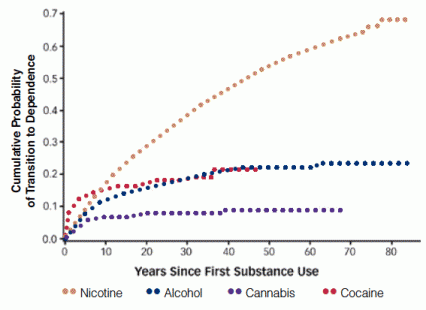First-time smokers have a 68 percent chance of sooner or later becoming nicotine dependent, according to a recent estimate based on national survey data. The probability of first-time alcohol, cocaine, and cannabis users transitioning to dependence was much less. For cocaine and cannabis, about half of the eventual cases of dependency occurred within 4 and 5 years, respectively, after first use. For alcohol and nicotine, half of the dependencies developed in 13 and 27 years, respectively. Estimates were based on self-report data from 15,918 nicotine, 28,907 alcohol, 7,389 cannabis, and 2,259 cocaine users who participated in the National Epidemiologic Survey on Alcohol and Related Conditions (NESARC).
Source
Lopez-Quintero, C., et al. Probability and predictors of transition from first use to dependence on nicotine, alcohol, cannabis, and cocaine: Results of the National Epidemiologic Survey on Alcohol and Related Conditions (NESARC). Drug and Alcohol Dependence 115(1-2):120–130, 2011. Abstract Available

